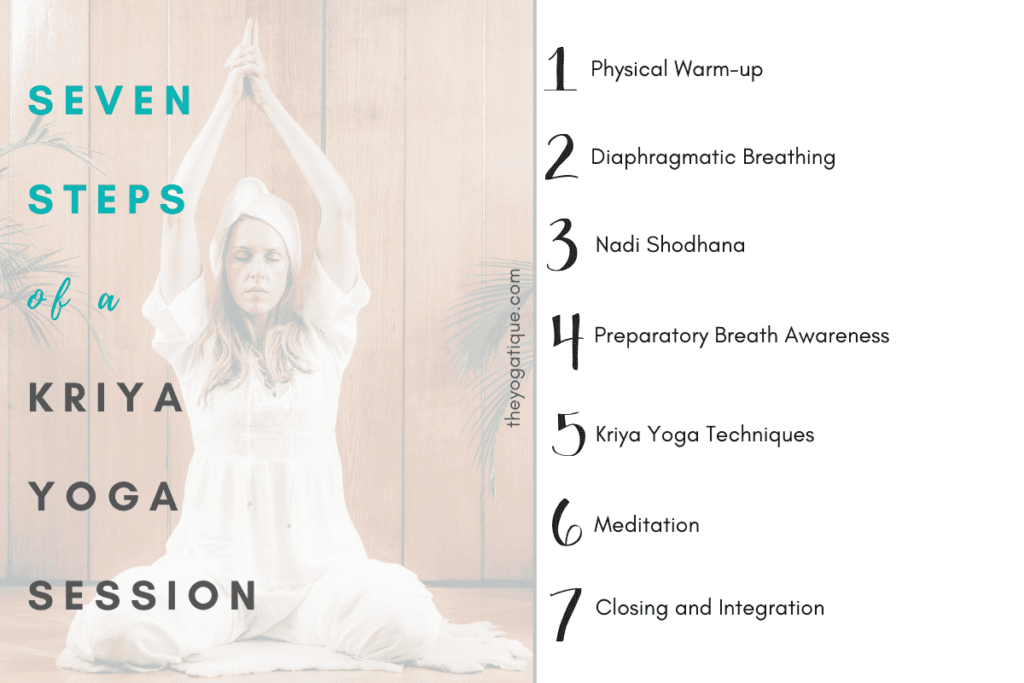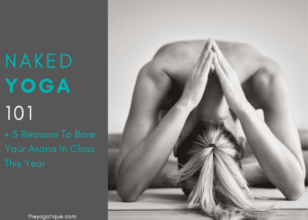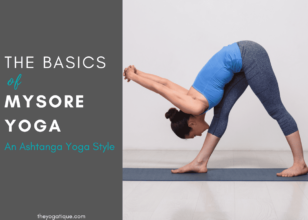Do you love yoga but prefer a style centralizing spirituality rather than exercise? If so, Kriya Yoga may be for you.
As an experienced yoga practitioner who has practiced many styles of yoga, Kriya is among the most profound. Rather than focusing on the physical body, Kriya Yoga is about connecting with your inner being. You do this through learning to utilize the life force within.
Intrigued? Then, read on to learn all about this ancient yogic practice!
Article content:
(Click any link below to jump directly to section)
What is Kriya Yoga?
Kriya Yoga is an ancient meditation technique and yoga style dating back centuries to Ancient India.
The first apparent reference to Kriya Yoga was in the Bhagavad Gita. But cryptic sentences in the Bible also suggest Jesus Christ was familiar with Kriya Yoga!
The Sanskrit term “kriya” means action or movement. In Kriya Yoga, this refers to specific meditation techniques/ spiritual practices taught. These include pranayama (breath control), mudra, mantra, and physical postures.
Kriya yogis believe that the breath and the mind are intimately connected. The concept is that by working with the breath through specific techniques, you can gain energy control. This in turn, accelerates spiritual development and connection to the divine consciousness.
This spiritual practice aims to awaken the life force (prana), which may help you reach higher states of cosmic consciousness.
The 3 core principles of Kriya Yoga
There are three core principles of Kriya Yoga, also known as the three pillars. These concepts are from the Yoga Sutras of Patanjali, which you may already be familiar with if you've studied yoga philosophy. The three pillars of Kriya Yoga are:
- Self-discipline (Tapas): Following a consistent and dedicated routine for their spiritual practices. Paramhansa Yogananda teaches we can increase life energy through disciplined effort.
- Self-study (Svadhyaya): Engaging in introspection, self-inquiry, and studying spiritual texts. This will deepen your understanding of the self and the nature of existence.
- Surrender to God (Ishvara Pranidhana): Cultivating a sense of humility, devotion, and surrender to the divine will. This is not passive surrender but acknowledgment and trust that divine love is guiding and supporting you.
This combination of the pillars and spiritual techniques like pranayama and mindfulness creates a balanced, transformative, and comprehensive spiritual path.
⬇Yoga Alliance registered yoga teacher trainings you should look into⬇
2 Kriya techniques for beginners
Kriya techniques are powerful practices within yoga that combine breath control, meditation, and movement to cleanse the body and mind, promoting spiritual growth. Here are two Kriya techniques that I recommend beginners learn first:
1. Nadi Shodhana
One of the most well-known examples of a yogic kriya is the Nadi Shodhana pranayama. It is also used in other yoga styles, known as alternate nostril breathing. This technique involves inhaling through one nostril and exhaling through the other. Here's how to do it:
- Inhale through the left nostril.
- Close the left nostril with your right ring finger, and release the right nostril.
- Exhale through the right nostril.
- Inhale through the right nostril.
- Close the right nostril again and release the left, exhaling through the left nostril.
- This completes one cycle; repeat for several cycles.
2. Ujjayi Pranayama
Ujjayi breathing, also known as ocean Breath, is another essential Kriya technique. It helps to regulate the nervous system and life energy, helping you move into a meditative state. Here's how to do it:
- Inhale deeply through your nose.
- Exhale slowly through your nose while constricting the back of your throat. Create a soft, audible sound like ocean waves as you do so.
- Continue this rhythm slowly, counting to six on the in-breath and six on the out-breath.
The 7 steps of a Kriya Yoga session beginners should know
Like with all yoga styles, preparation is essential. Every Kriya Yoga practice starts with preliminary practices for centering and intention setting.
Start by finding a comfortable seated position. Close your eyes and connect to your breath. Then, set an optimistic and focused intention for the practice. The 7 basic steps to start a Kriya Yoga session include:
- Physical Warm-up – Gentle yogic stretches can prepare the body for sitting meditation. Specific movements include neck stretches, shoulder rolls, and seated twists.
- Diaphragmatic Breathing – Inhale deeply through the nose, allowing the diaphragm to expand. Then exhale slowly.
- Nadi Shodhana – This consists of inhaling and exhaling through alternate nostrils.
- Preparatory Breath Awareness – Here, you observe your natural breath. Bring attention to the sensation of your breath at the nostrils or the rise and fall of the chest.
- Kriya Yoga Techniques – This is the primary part of the practice. It includes various pranayama techniques, mantra repetition, and chakra visualization.
- Meditation – After the kriyas, you come into a seated meditation posture to find stillness and inner peace.
- Closing and Integration – You finish with a few moments of silent sitting before practicing gratitude or a closing prayer.

4 benefits of Kriya Yoga
While Kriya Yoga has many positive effects on our physical and mental bodies, it is a spiritual practice. Through regular practice, practitioners report heightened spiritual awareness and interconnectedness with the universe.
Like other yoga styles, Kriya Yoga can enhance your physical and mental health in many ways, including:
- Improved functioning of the respiratory system and enhanced lung capacity (through breath control)
- Enhanced concentration and mental clarity (through meditation)
- Reduced stress (through nervous system regulation)
- Increased vitality and physical energy (through the improved flow of life force)
What makes Kriya Yoga different?
As someone with years of experience practicing many different styles of yoga, I feel Kriya Yoga is unique. It's one of the more spiritual yoga styles as there is much less emphasis on the physical benefits than in Hatha, Ashtanga, and Vinyasa yoga.
Kriya Yoga also has more emphasis on pranayama. While other yoga styles may include 5-10 minutes of breathwork, in Kriya Yoga, it is integral throughout the entire practice.
This is because ancient yogis discovered the connection between the breath and our life force. By regulating the breath, we achieve life force control. This leads to the purification of the energy channels in the body and the awakening of higher states of consciousness.
Takeaway
Kriya Yoga may not be the most popular style among western yogis. But, if Hatha and Vinyasa yoga no longer tick all the boxes for you, Kriya Yoga is the perfect style to advance to.
Featuring meditation, breathwork, and other techniques, Kriya Yoga is THE practice for all dedicated spiritual seekers.
Some online yoga studios, online yoga teacher training programs, and brands that we write about may offer us a small commission should you decide to make a purchase or signup after reading our content. Thank you for enabling us to exist!











